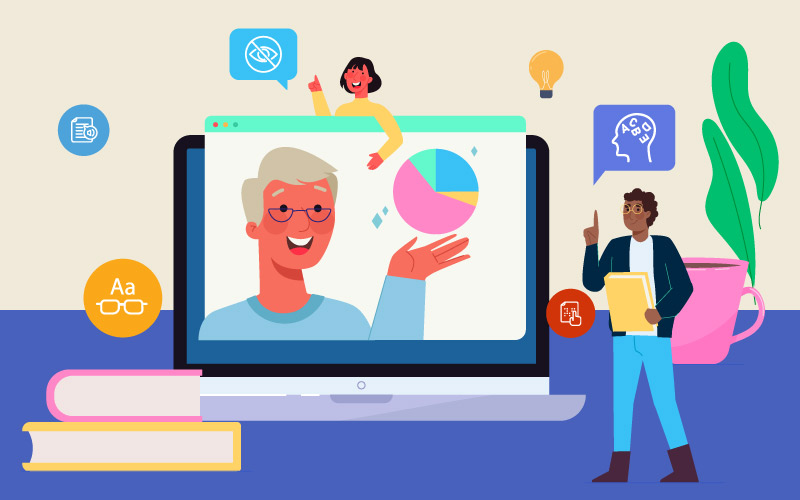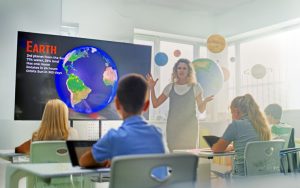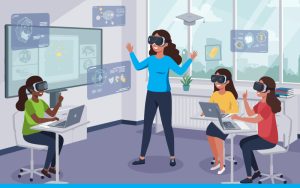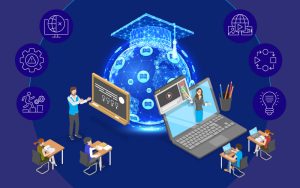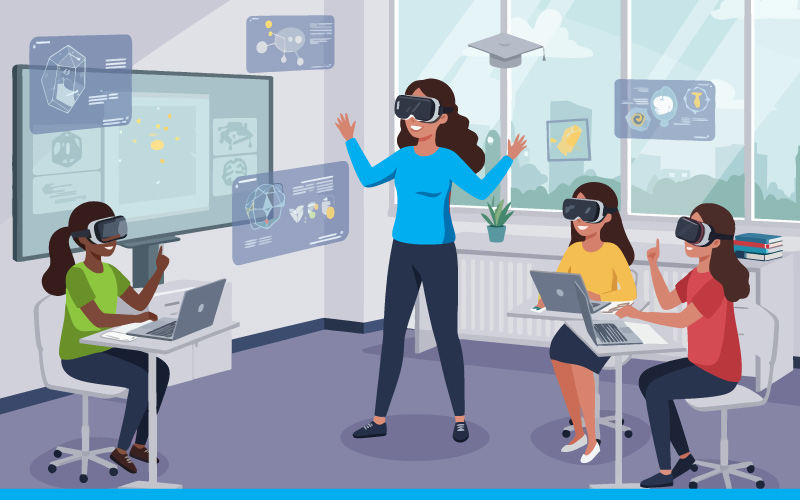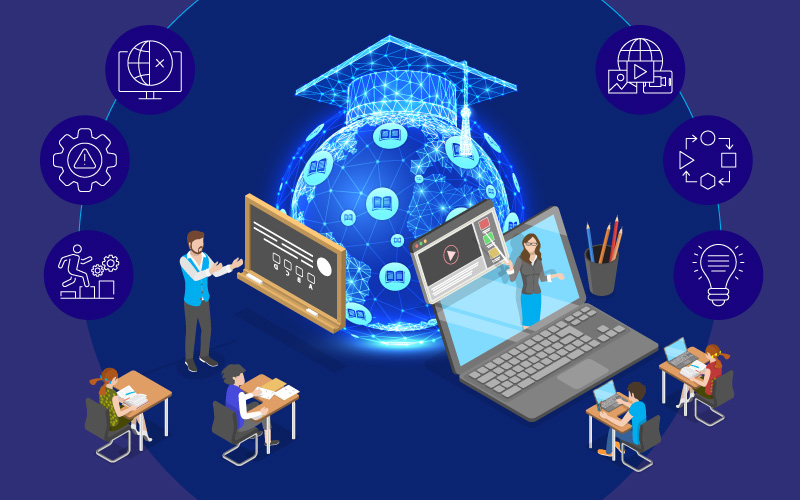Digital accessibility is rapidly moving from a nice-to-have to a legal and moral imperative in K–12 education.
Worldwide laws and regulations, like as the Public Sector Accessibility Regulations in the UK and the current Title II rule from the U.S. Department of Justice, now require schools to make their online content accessible. Meeting the Web Content Accessibility Guidelines (WCAG) criteria is what this actually entails. To do this, all teachers must receive specialized training in accessibility principles and take on the role of WCAG champions in their classrooms and schools. Encouraging educators to understand accessible design guarantees that learning resources (websites, papers, videos, and apps) can be used by students with a range of disabilities. This blog examines the importance of WCAG and inclusive design training for teachers, its contents, and the ways in which professional development (PD) programs can be designed to help teachers become successful advocates.
We will draw on recent research and examples from the US, UK, Europe, and even APAC/Middle East contexts to offer a comprehensive guide.

Why Teacher Training in Accessibility Matters
Digital resources such as learning management systems, online textbooks, educational apps, movies, and more are widely used in schools nowadays. Technology has the potential to enrich education, but it can also create obstacles. Materials without alt text, subtitles, or keyboard navigation may leave behind students who are blind, deaf, or have cognitive or mobility issues. According to research, teachers in grades K–12 frequently lack the skills necessary to provide an inclusive curriculum or enough understanding of the needs of students with disabilities.
At higher ed institutions, a Quality Matters study found that “faculty are ultimately responsible for ensuring that their online courses adequately meet the learning needs and requirements of all students” yet many lack basic accessible design skills. The same logic applies in K–12: teachers are on the front lines of education and need awareness of WCAG principles (perceivable, operable, understandable, robust) to reduce barriers.
Effective accessibility training has a ripple effect. Instructors with positive attitudes toward inclusion and the right tools can dramatically improve student success. For example, teachers who understand captioning are more likely to caption their videos (helping deaf students and even English learners), and those trained in clear, readable layouts benefit students with dyslexia or cognitive disabilities. As the CoSN / NC State “Accessibility Playlist” initiative notes, core topics like legal requirements and Universal Design for Learning (UDL) strategies are central to inclusive K–12 education. In short, by making teachers the champions of WCAG compliance, schools ensure that accessible practices become part of everyday teaching rather than an afterthought.
Moreover, legal pressures are mounting. In the U.S., the 2024 DOJ rule under Title II requires school districts to meet WCAG 2.1 Level AA standards. Districts serving 50,000+ students must comply by April 2026, with others following by April 2027. The UK’s Public Sector Bodies Accessibility Regulations similarly require WCAG 2.2 AA conformance for public websites and apps (note: primary/secondary schools have narrow exemptions on non-essential content, but most educational content should still be accessible). Globally, accessible design is becoming the norm: Australia’s 2023 disability discrimination law, India’s RPwD Act, and Singapore’s regulations all reference WCAG criteria; the UAE’s 2020 Disability Act explicitly aligns with WCAG 2.1 AA (even mandating bilingual support in schools). All these mandates mean that by training teachers, districts also safeguard against legal and reputational risk.
“Accessibility is more than a checklist; it is an ongoing commitment to fostering an inclusive educational environment,” notes CoSN.
Schools show their commitment to equality by making accessible teacher professional development a priority. Not only do inaccessible materials infringe students’ rights, but they also hinder their involvement and academic performance.
Training educators builds a culture where digital inclusion is as routine as grading papers.

Accessibility and Inclusive Design Foundations
Before getting into training models, let’s establish the key concepts. Perceivable, Operable, Understandable, and Robust (POUR) are the four guiding principles of WCAG (Web Content Accessibility Guidelines), the international standard for web and digital content accessibility. In practical terms, this is making sure all students, regardless of ability, can see, hear, navigate, and understand the material.
For example, all images should have meaningful alt text (Perceivable), video content needs captions and transcripts (Perceivable & Operable), interfaces must work via keyboard (Operable), and language should be clear (Understandable). A fully accessible lesson might include multiple “means of representation” – text, audio, video, hands-on activity – following Universal Design for Learning (UDL) principles.
An effective WCAG training program for educators covers both these technical standards and the broader mindset of inclusion. According to Teach Access’s recommended fundamentals, training should begin with understanding disability, including common types (e.g. visual, hearing, cognitive, motor) and how they affect learning. Teachers should then learn the societal and legal context – for example, how the ADA (US) or Equality Act (UK) relate to digital access, and how WCAG was developed by the W3C as an international guideline.
Common assistive technologies (screen readers, magnifiers, captioning tools) and their interactions with content are covered in the practical sections that follow. Additionally, common user interface hurdles (poor contrast, missing labels, confusing layouts) and their solutions are discussed. Along with teaching how to test with actual users or assessment tools, training also covers best practices for content preparation, including how to use appropriate headings, design for keyboard navigation, write alt descriptions, caption media, and organize documents.
To tie it together, show teachers “why” these techniques matter. For instance, demonstrate how a blind student uses a screen reader to experience a webpage, or how a dyslexic learner benefits from good color contrast and plain language. Designing training to model accessibility helps. As one expert notes, an effective course “follows both WCAG 2.2 standards and UDL principles” itself – providing screen-reader-friendly content, captions on videos, multiple interaction modes, etc. – so that educators experience accessible learning first-hand. In short, WCAG training is not just about compliance rules: it’s about building inclusive pedagogy.

Global and Legal Context for K–12 Accessibility
Understanding the regulatory environment helps motivate training.
As mentioned, U.S. law now explicitly requires WCAG compliance in K–12. Likewise, in the UK and EU, laws demand accessible content.
According to the UK Public Sector Bodies (Websites and Apps) Accessibility Regulations 2018 (modified for WCAG 2.2), the majority of online services and school websites must make themselves accessible.
Even though elementary and secondary schools are excluded from some requirements (they simply need to make the content accessible so that users can access the service), it is still recommended practice to fully comply. According to the European Accessibility Act, which will go into effect in 2025, many educational items (such as software, e-books, and learning platforms) must adhere to EU-wide accessibility criteria that closely mirror WCAG.
Even in regions without formal school-specific laws, governments are moving in this direction: for example, Canada’s Rick Hansen Foundation now offers mandatory PD to make educators more inclusion-aware, and the Middle East is catching up fast.
scroll right to read more
| Region | Policy / Regulation | Accessibility Standard | Deadline / Notes |
|---|---|---|---|
| United States | ADA Title II (DOJ rule, 2024) | WCAG 2.1 Level AA | Public school districts must comply by Apr 2026 (≥50k stud.) or Apr 2027. |
| United Kingdom | Public Sector Accessibility Regulations (2018) | WCAG 2.2 AA | In force since 2018. Primary/secondary schools are partially exempt (except essential content). |
| Europe (EU) | European Accessibility Act | WCAG 2.1/2.2 AA | Adopted 2019; enforcement by 2025 for covered products/services. |
| APAC | Various (e.g. Australia’s DDA 2023, India RPwD Act) | WCAG 2.1 AA (often 2.0 minimum) | Australia and Singapore already require WCAG 2.1 AA; India’s law references earlier WCAG. |
| Middle East | UAE Disability Act (2020), Saudi NAP (National Acc.) | WCAG 2.1 AA | UAE explicitly aligns with WCAG 2.1 AA; Saudi Arabia’s NAP drives similar standards. |
Table 1: Major policies requiring WCAG compliance in K–12 education.
The takeaway: districts and schools cannot delay. Legal compliance aside, aligning with these standards ensures that educational content truly serves all learners. Knowing this global context can be motivating in training sessions: teachers see that accessibility is not optional but part of modern teaching responsibilities.

What Should WCAG Teacher Training Cover?
Effective professional development (PD) in WCAG for educators blends theory, demonstration, and practice. A robust training program might include:
- Understanding Disability and Accessibility Principles: Teachers start by learning about diverse disabilities and how they impact learning. This builds empathy and context. Topics include common disabilities in the classroom (visual, hearing, mobility, cognitive) and the functional needs of each. Instructors discuss how accessibility is a civil right (ADA, Equality Act) and how standards like WCAG were created to address these needs.
- Key Accessibility Guidelines (WCAG): Educators review the WCAG POUR framework. They learn specific requirements such as alt text for images (SC 1.1.1), captioning videos (SC 1.2.x), readable fonts and contrasts (SC 1.4.x), logical headings and structure (SC 1.3.1, 2.4.x), and operability (keyboard access, SC 2.1.1). Rather than expect teachers to memorize all criteria, training focuses on the rationale behind them. For example, P-O-U-R is used as a lens to check each lesson: Is it Perceivable, Operable, Understandable, Robust? Tools or checklists (like a simple WCAG self-audit) help practice.
- Assistive Technology (AT) Awareness: Teachers explore how common AT works. Demonstrations of screen readers, magnifiers, voice controls, captioning apps, etc., help make the connection. Knowing that WCAG guidelines enable these technologies is crucial. For instance, teachers might try navigating a sample webpage with a screen reader, or testing video playback with captions. The goal is not to turn every teacher into an AT expert, but to instill awareness: a teacher who has “seen” a student’s perspective is more likely to avoid accessibility pitfalls.
- Accessible Content Creation: This is the hands-on core. Topics include: creating accessible documents (tagged PDFs, proper use of heading styles), making presentations (clear layout, alt text, high contrast), authoring accessible web pages or LMS modules (descriptive link text, skip navigation links), and captioning multimedia (adding transcripts or subtitles). Teachers also learn to evaluate and select accessible educational software and websites. For each topic, real classroom examples are used: e.g., converting an image of a diagram into one with alt text, or adding captions to a sample science video. The Quality Matters needs assessment notes that educators often need PD in exactly these areas (plain language, alt text, table design, consistent navigation).
- Classroom Implementation Examples: Training doesn’t end with theory. Educators explore practical scenarios: how to deliver an accessible online lesson, how to support a student who uses assistive tech during a class, and how to provide materials in alternative formats (e.g., accessible e-books, Braille transcripts). For instance, a math teacher might learn to speak aloud slide content and describe graphs for blind students. An English teacher might practice using a text-to-speech tool or learning app that reads aloud stories. These examples make the PD relevant and immediately actionable.
- Tools and Resources: Teachers are introduced to online tools (like WAVE, Accessibility Checker, or platform-specific trainers) and organizational resources (e.g., district accessibility guidelines, WCAG checklists). Courses like W3C’s free “Introduction to Web Accessibility” or CAST’s self-paced modules can be part of independent learning. The key is to equip teachers with references they can revisit – from official WCAG Quick Reference (W3C) to curated [internal resources on accessible instruction].
Importantly, training should emphasize that accessibility aligns with Universal Design for Learning (UDL): many inclusive teaching strategies benefit all students. Providing multiple ways to access content (text, audio, video), offering choices (e.g., reading vs listening), and removing unnecessary barriers are UDL practices that coincide with WCAG guidelines. By framing WCAG within UDL, teachers see accessibility not as extra work, but as good teaching.

Professional Development Models and Approaches
School districts and education agencies have adopted various PD models to train educators in accessibility. Some effective approaches include:
- Online Self-Paced Courses: Flexible e-learning modules allow teachers to learn at their own pace. These can range from short interactive tutorials (e.g. 20–30 min micro-modules on “Writing Alt Text”) to longer courses (e.g. a 4-hour Introduction to Accessibility). For example, Stride and other PD providers offer on-demand accessibility courses designed by teachers for teachers. Online courses are convenient for busy educators and can include quizzes, videos, and downloadable guides. The CAST organization, for example, offers free self-paced modules on accessible material design, which teachers can take during weekends or planning periods.
- Workshops and Webinars: In-person or live virtual workshops allow for deeper engagement. A facilitator (often an assistive tech specialist or experienced instructional designer) guides teachers through hands-on activities. Workshops can be half-day or full-day events. For instance, a workshop might walk teachers through evaluating their own websites using a WCAG checklist, or collaboratively caption a video. Schools have found success by embedding such workshops into regular in-service days or tech training days. The key is interactivity – using breakout groups, reflection exercises, and peer-sharing. According to CAST, their interactive accessibility workshops help participants “gain practical knowledge on integrating accessible materials” and are offered both in-person and virtually.
- Peer Mentoring and Coach Models: Pairing teachers with tech coaches or “accessibility mentors” can provide personalized support. In this model, a tech specialist or trained teacher works one-on-one or in small groups with colleagues. They might help audit a teacher’s slide deck, or co-plan a lesson to ensure it meets accessibility checks. Research shows that ongoing mentoring promotes sustained change. For example, some districts have “digital learning coaches” who include accessibility in their portfolio: they observe classrooms or co-teach lessons, giving feedback on accessibility issues. This peer-coaching model fits well with the collaborative culture schools often encourage.
- Communities of Practice (CoP): Encouraging educators to form CoPs focused on accessibility can spread expertise. A CoP might meet monthly to discuss challenges, share success stories, and troubleshoot issues. For instance, an “Accessible Learning Working Group” of general educators, special educators, librarians, and IT staff can review one another’s materials and share resources. The CoSN Accessibility Playlist itself is a form of CoP resource: educators self-assess then collaborate on improvement strategies. Sustaining a CoP ensures that “WCAG champions” don’t work in isolation and that knowledge proliferates.
- Blended and Micro-Credential Programs: Some districts integrate accessibility into broader technology PD. For example, earning a digital badge or micro-credential in Accessibility can motivate teachers. A blended program might include a short online component followed by a reflective assignment. Google’s Applied Digital Skills and other providers have begun offering K–12-specific accessibility badges. Completing a project (like redesigning a worksheet for screen reader compatibility) could earn a certificate. This approach gamifies learning and gives teachers a tangible achievement, while ensuring accountability.
- Train-the-Trainer: To scale impact, some districts train a subset of staff who then train others. For instance, a district might send a few teachers or instructional designers to become certified in a WCAG/IAAP course. Those trainers then cascade knowledge through faculty meetings or grade-level teams. The Quality Matters study noted that many institutions focus PD on small groups (faculty developers, instructional designers) who can then support others. This model builds internal capacity over time.
These models often work best in combination. Table 2 outlines common PD formats, their benefits, and sample use cases:
scroll right to read more
| Model | Description | Benefits | Example/Application |
|---|---|---|---|
| Online Self-Paced | E-learning modules (video/text/quiz) accessible anytime. | Flexible; can be revisited; scalable to many. | Coursera-like courses on “Inclusive Design” taken individually by teachers after school. |
| Workshops/Webinars | Live sessions with an instructor. Often include hands-on activities and Q&A. | Interactive; immediate feedback; cohort learning. | Half-day webinar on “Captioning Video Lessons” with examples. |
| Peer Coaching/Mentoring | One-on-one or small-group sessions with a specialist or experienced teacher guiding real lessons/materials. | Personalized support; builds collaboration. | Tech coach reviews a teacher’s LMS content and suggests fixes. |
| Communities of Practice | Group of educators meets regularly to share resources, discuss challenges, and collaboratively solve accessibility issues. | Sustained culture change; shared expertise. | Monthly school accessibility team meeting with IT and teachers. |
| Micro-Credential/Badges | Modular program where teachers complete tasks/projects to earn certification. Includes online + practice components. | Motivates with credentials; bite-sized learning. | Earning a “Digital Accessibility Badge” after creating a compliant lesson plan. |
| Train-the-Trainer | Training selected staff thoroughly so they can train peers. | Multiplies impact; builds internal experts. | A few curriculum specialists complete a WCAG bootcamp, then run school PD. |
Table 2: Examples of PD models for training educators in accessibility.
Each school or district can choose a mix that fits its context. For example, rural schools might rely more on online courses, whereas urban districts might host in-person workshops. Crucially, PD should be ongoing and supported by leadership. Instead of a one-off seminar, the “WCAG champion” model means teachers continually refine their skills and share them.

Examples of Accessibility Training in Action
To illustrate, consider a few real-world initiatives:
- Statewide Accessibility Playlists (USA): In North Carolina, the Friday Institute and CoSN developed the Accessibility Playlist – a two-part self-assessment and resource guide for educators. Teachers begin by evaluating their own practices (marking what’s already accessible and what needs work) and then follow tailored guidance. The playlist covers legal requirements, UDL, support for English language learners, multimedia strategies, and more. Early feedback shows it helps educators take “small, manageable steps toward more accessible classrooms”. This kind of self-directed program complements formal training by encouraging reflection and continuous improvement.
- Universal Design for Learning (UDL) Courses (CAST): The CAST organization offers extensive PD, including an “Introduction to Designing for Accessibility” (aligned with UDL). In these workshops, educators learn how accessible design is part of the broader goal of meeting learner variability. For example, in one district’s training, teachers spent a day prototyping lesson plans that automatically included alternatives (e.g., reading text aloud, providing graphic organizers). Such training explicitly links WCAG-level fixes with UDL benefits, reinforcing that the same steps (like captioning a video) help many students.
- Nonprofit and Community Programs: Organizations like the Rick Hansen Foundation in Canada run programs called Educator Inclusion and Accessibility. One self-paced e-learning (4-hour) course teaches vision, hearing, and mobility inclusion basics.
- Online Accessibility Bootcamps: Some districts partner with tech accessibility providers for intensive training. For example, a K–12 school system might send a team to a Deque University or similar bootcamp. They learn both theory and tools, then return to hold briefings for staff. Others have created “Accessibility Champs” programs: volunteer teachers take a certification (like the IAAP CPACC) and then mentor colleagues. Post-training surveys often show increased confidence: many teachers report they feel more capable of addressing student needs after targeted PD.
- Improvement through Practicum: In a progressive approach, trainers have teachers apply lessons immediately. For instance, after a workshop on accessible documents, teachers spent time converting one of their own PDFs into an accessible version, with help from trainers. By the end, they saw the difference: headings became selectable, alt text made graphs speakable. This hands-on practice cements learning far more than lectures. It aligns with one expert’s model where, by the course midpoint, learners “are no longer just absorbing—they’re applying… auditing their own courses and materials with a new lens”.
These examples show that successful training is interactive, ongoing, and focused on actual classroom materials. Whether through a curated playlist, a one-day workshop, or a year-long coaching program, the goal is the same: make every teacher a steward of accessibility.

Embedding Accessibility into School Culture
Training teachers is only the first step. To create lasting change, accessibility must become part of the school’s DNA. This means supporting teachers after the workshop and ensuring policies reinforce inclusion. Key strategies include:
- Leadership Support and Policies: Principals and district leaders can signal that accessibility is a priority. This might mean setting policies that all new digital resources be reviewed for accessibility, or including accessibility goals in school improvement plans. For example, some districts now require every new teacher-created curriculum to pass an accessibility check before being published in the LMS. Even simple steps like providing an accessibility statement on the school website (as UK law requires) reinforce that this is a non-negotiable standard.
- Cross-Functional Teams: Form an interdisciplinary accessibility committee. Quality Matters research suggests including faculty developers, instructional designers, and technology staff in training efforts. A K–12 version of this might bring together a special ed teacher, an IT specialist, a general educator, and a counselor, meeting regularly to review materials and plan training. MITR’s guide recommends just this: “Form an accessibility team that includes IT, special education, curriculum, and legal” to evaluate content with a WCAG checklist. Such teams ensure consistency (not every teacher has to be an expert, but they have an expert to consult) and keep momentum.
- Student Involvement: Paradoxically, students can help educators learn. Older students who use assistive tech (e.g. screen readers or captioning) can provide real feedback. One district encourages 9th graders to test new learning apps or websites and report issues. This not only gives practical insights but empowers students. MITR’s roadmap emphasizes giving students a voice: a 10th grader might point out missing alt text on images, highlighting gaps between theory and practice. Involving students makes the need for accessible design tangible, not theoretical.
- Continuous Improvement: Finally, view accessibility as an evolving process. Technologies and standards update; WCAG 2.2 has added new criteria, and WCAG 3.0 is on the horizon. Regularly revisit and refresh training. Schools can build cycles (e.g., annual “accessibility refresh” mini-competitions or updates) to maintain attention. PD can include follow-up sessions where teachers share new ideas or audit each other’s work. As one guide puts it, “Accessibility isn’t a one-time checklist; it’s iterative”. By institutionalizing periodic review (for example, re-running accessibility checks whenever curricula change), accessibility stays current.
- Celebrate Champions: Recognize and reward teachers who excel at accessibility. Simple measures – mentioning accessibility in staff newsletters, giving out certificates or micro-grants for innovative accessible projects, or featuring examples in staff meetings – go a long way to keep interest high. When teachers see that their efforts to be inclusive are valued by their peers and administration, it reinforces the norm.
By combining training with these supportive structures, schools create an environment where WCAG compliance is part of the culture. Teachers talk about it, learn from each other, and feel backed by leadership. This is how true champions are formed: educators who not only apply accessibility themselves, but mentor peers, update procedures, and ensure no student is left behind.
Conclusion
Training educators as WCAG champions is an investment in the school’s future. It ensures compliance with evolving laws, but more importantly it unlocks the potential of all learners. With the right professional development – covering both the technical “how-tos” and the inclusive mindset – teachers can transform their digital classrooms. They will create materials that are perceivable, operable, understandable, and robust for every student.
As the research shows, even well-intentioned teachers often don’t know what they don’t know about accessibility. Quality PD can close that gap. Whether through self-paced courses, interactive workshops, mentoring, or collaborative communities, effective programs make accessibility practical and immediate. They give teachers tools to caption that science video, add alt text to an art slide, or format a document with headings – steps that benefit all learners.
Ultimately, when educators become advocates for accessibility, the whole school ecosystem improves. Classrooms become more innovative and responsive, families see that diverse needs are respected, and students with disabilities get the support they deserve. The global momentum – from U.S. and EU mandates to initiatives in APAC and the Middle East – tells us the time is now. By starting with teacher training in WCAG, schools lay the groundwork for equity in education.
Sources: References were taken from Quality Matters, CAST, CoSN, Teach Access, and others for this guide. For example, Quality Matters notes that “professional development in digital accessibility… is of paramount importance” for faculty while CoSN provides an Accessibility Playlist covering essential practices. Regional policies are cited from the U.S. DOJ rule and UK Government sources. Examples of PD successes come from organizations like the Rick Hansen Foundation and CAST. These and additional references are cited throughout.


